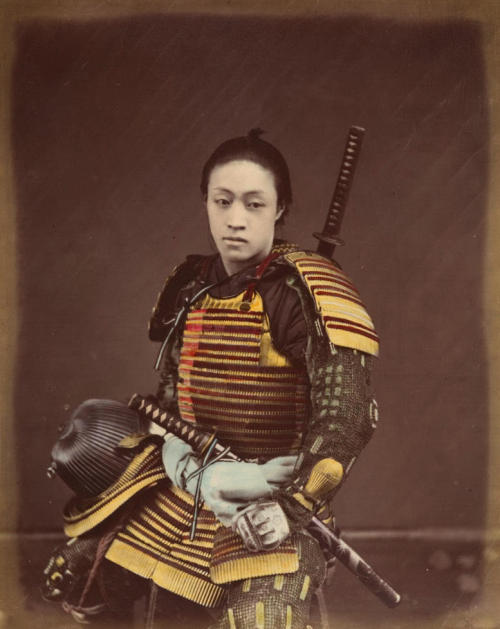#shinichi suzuki
MWW Artwork of the Day (3/27/16)
Shin'ichi Suzuki (Japanese, 1835–1919)
Actor in Samurai Armor (c. 1872-76)
Albumen silver print from glass negative, 24.6 x 18.9 cm.
The Metropolitan Museum of Art, New York (Gilman Collection)
Adventurous Westerners like Felice Beato and Baron Raimund von Stillfried-Rathenitz brought photographic technique to Japan in the 1860s and by the next decade there were dozens of Japanese practicing the new art. Suzuki Shin'ichi I – not to be confused with a younger photographer with the same name – was one of them. He began his working career in his family’s sericulture business, but on trips to Yokohama fell in love with the new magic of picture-making and enrolled himself as an apprentice at the Yokohama photographic studio of Shimooka Renjo in 1867. In 1872–1873 he was commissioned by J. R. Black, publisher of “The Far East,” to produce a photographic series documenting rural life, images of which continued to appear in his albums until the 1880s. In November 1873 Suzuki set up his own studio, producing portraits and souvenir albums. In 1884 he moved to a newly-built, western-style two-storey studio. A branch studio was opened in Kudanzaka, Tokyo and operated by his son-in-law, Suzuki II. Suzuki’s photographs were highly acclaimed and he won an award for them in 1877, and in 1889 he and Maruki Riyo were commissioned to photograph Emperor Meiji and his wife. Purchasers of his works were mostly foreign residents and visitors, and in addition to sales from his own studio, Suzuki’s photographs were distributed by Sargent, Farsari & Co. His studio was advertised as early as 1880, in Keeling’s Guide to Japan, and subsequently in the Japan Directory until 1908, offering daguerreotypes, photographs (including large format hand-coloured albumen prints), and Suzuki’s innovation of photographs printed on porcelain, the latter selling for 12 yen each. Suzuki Shin'ichi retired in 1892 and died in December 1918 at the age of 83.
Suzuki’s pictures reveal a country moving toward Westernization in the decades after Commodore Perry’s black ships stormed into Yokohama Bay. Whereas Beato’s samurai was a warrior who exuded the pride and disciplined ferocity of his caste, this samurai here is actually an actor. He wears the martial trappings of a feudal class abolished in the early years of the Meiji Restoration. Following Beato’s practice of coloring photographs to please local taste, Suzuki had the image heavily tinted, probably by a painter attached to the photographic studio solely for that purpose.
The picture is one of a group of forty-eight images that offer a rather conventional sampling of Japanese characters and genre scenes by various photographers. Roughly captioned in English, they were inserted into an elegant album of Chinese photographs captioned in French.
(adapted from several sources)
* This is one of a series of photographs from the 19th c. – all of great historical interest – that are included in the MWW “Camera Eye” Special Collection. Some of the commentaries for these pictures contain information about the early history and development of photography.
Post link

